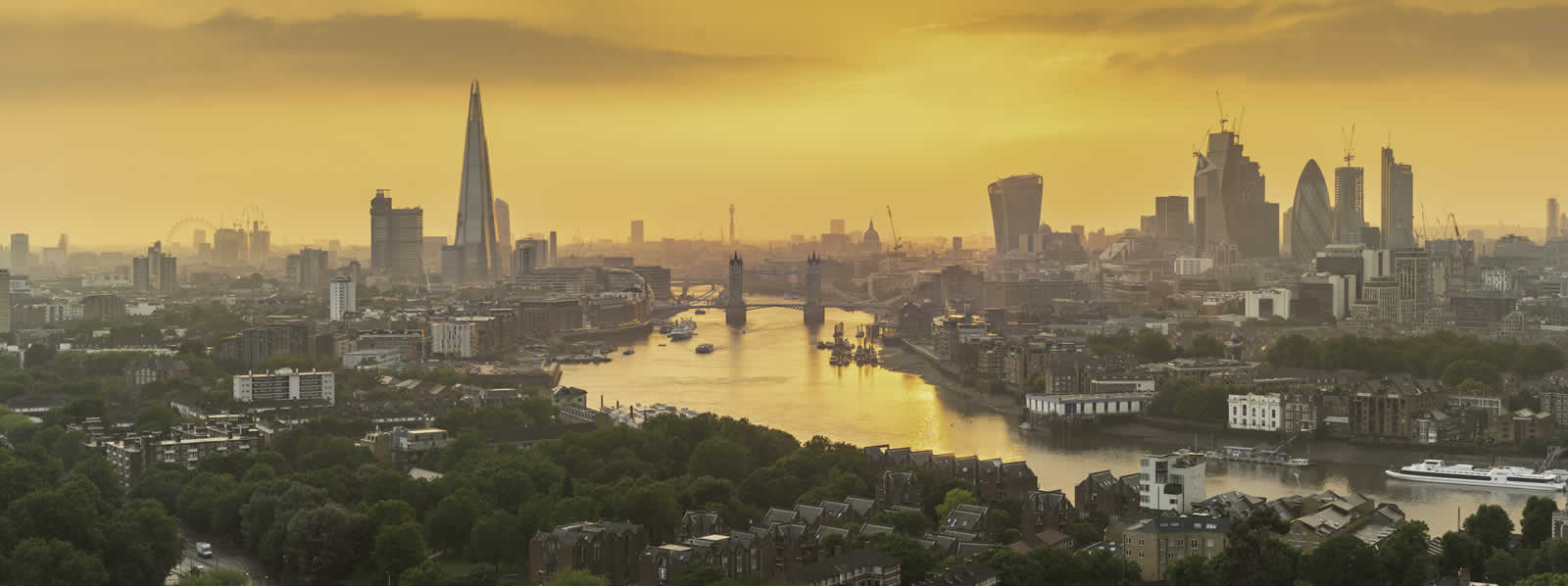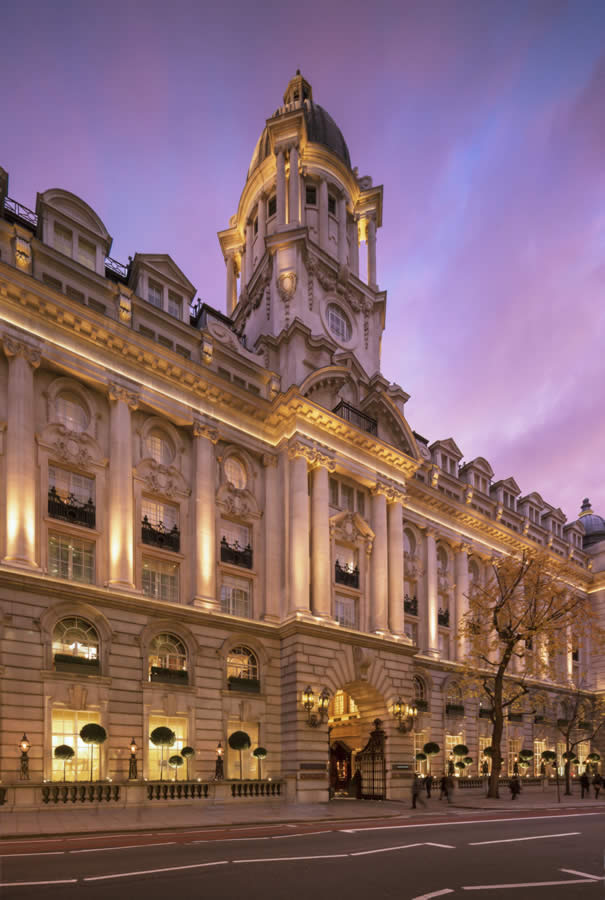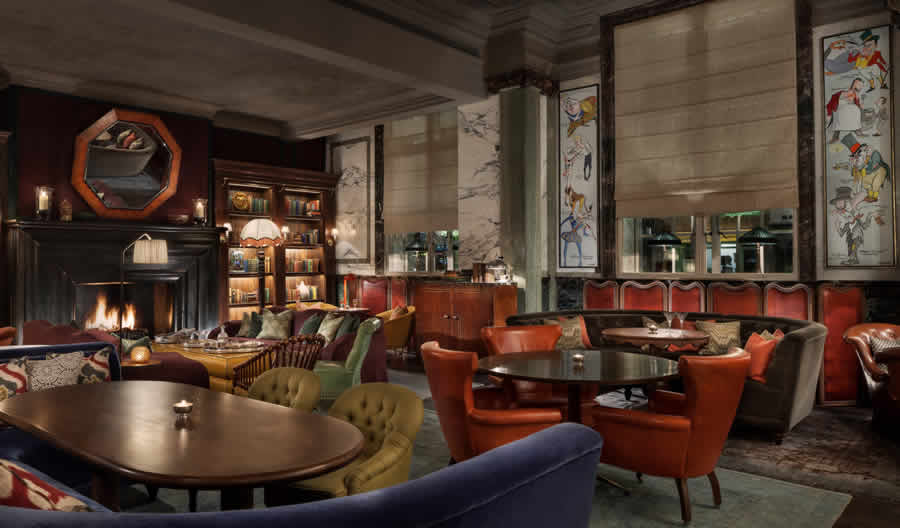DESPITE A RAPIDLY CHANGING WORLD, BRITISH CAPITAL RETAINS ITS MAGIC
By Edward Kiersh
Much like the rest of frenzied London – a city newly defining itself with a swath of revived neighborhoods, clamorous antique markets and trendy restaurants – the High Holborn business district next to popular Covent Garden teems with dizzying activity.
But, unknown to most passersby, past one stately building’s arched carriageway, through an expansive courtyard and beyond a row of Maseratis, a distinctive world opens up – a magical, luminous escape. It’s deliciously part English manor house, part contemporary homage to exquisite decorative objets d’art, gleaming rose bronze and lacquered glass fixtures, and impeccable hotel service.
All this is the Rosewood London Hotel. Recently redesigned by famed architect and designer Tony Chi, this grand 1914 Edwardian Belle Époque building has long been used as a backdrop and film set. But now, there’s an undeniable sparkle – glimmering with marble and alpaca tile bathrooms, the lively Scarfes Bar with 300 whiskies, and bespoke furnished suites. Each is a soothing oasis, distinguished by mounds of art books, stunning floral arrangements, sitting rooms and butler service.
“I wanted to capture the sense that London lives in the past and future,” says Chi, who designed the 262 guest rooms, 44 suites (one boasts its own postal code) and public areas. “London is Rule Britannia, Dickens, Churchill … a place where ghosts are as vital as the city’s global importance, so I wanted to create distinct memories, romantic seductiveness, and a charming modernity.”
While the palazzo-like exterior, grand Pavonazzo marble staircase and Cuban mahogany fireplaces accent the past, the Rosewood also reflects the changes sweeping through London. Public houses, the iconic pubs of yore, are disappearing. While grande dame hotels like The Lanesborough, Claridge’s, and Ten Manchester Street, along with Fortnum & Mason (an upmarket department store understandably acclaimed for its jams and preserves) serve delightful, ritualistic afternoon teas, classical tearooms are giving way to a preponderance of Starbucks-like chains.
Perhaps the greatest transformation is due to the weakened British pound (a wonderful development for Americans interested in buying art and antiques). Foreign speculators have swooped in, dramatically altering the character of neighborhoods like St. James’s, Mayfair and Knightsbridge by bulldozing quaint, white Georgian townhouses and replacing them with mega-complexes. Today, as CNN recently reported, luxury means a “tall tower addiction,” a speculative rush to build commercial and residential skyscrapers.
Brexit might just stop that infusion of money. Britain leaving the European Union after a 44-year partnership might ultimately impact the city’s historic openness, vitality and cosmopolitanism. In the meantime, crowds still throng Soho eateries like Blanchette, Bill’s and Yauatcha, and it’s exhausting to wade through the shoppers flocking to Oxford Street or Piccadilly Circus. They are indifferent to Brexit’s worst-case scenarios.
In any event, even if historic London is partly synonymous with Jack the Ripper and Charles Dickens’ miscreants – enough evil-doing for Lord Byron to call the city the “devil’s drawing room” – this sprawling metropolis offers far more than Bleak House redux. There’s limitless grandeur, inimitable opportunities to gape at riches, whether it’s the Crown Jewels in the Tower of London, majestic Westminster Abbey, or enjoying the remarkable views after climbing the 528 steps into the dome of the 1,400-year-old St. Paul’s Cathedral.
“London is Rule Britannia, Dickens, Churchill … a place where ghosts are as vital as the city’s global importance,” says designer Tony Chi, who updated the Rosewood London’s interior, including the hotel’s lively Scarfes Bar. Photographs courtesy Rosewood London.
TUBE-CONNECTED LONDON is also about reinvention, renewal and renaissance. That spirit of rebirth is especially dynamic along the South Bank of the Thames. Once home to brothels and cast-off bodies, this area was “the most dreadful place in the metropolis,” as Peter Ackroyd notes in his splendid London: The Biography.
Now symbolic of the “new” London, this riverside district is a major entertainment center, the site of the Coca-Cola London Eye Ferris wheel, and the 95-story skyscraper known as the Shard. Both attractions are jaw-dropping, but equally magnetic Borough Market pulsates with frenetic activity, a must-stop for coffee houses, fishmongers and cheese shops.
Then there’s Tate Modern. Far more than a futuristic-looking tower with cavernous galleries and over 70,000 works of art, this architectural delight offers a comprehensive array of 20th century legends (Giacometti, Picasso, Warhol, Dali), a bar, and a restaurant affording spectacular 360-degree views of the London skyline.
Art is everywhere in this city. The numerous Mayfair antique and art emporiums, the relaxing Serpentine Galleries in Hyde Park, and the cutting-edge Saatchi Gallery exhibitions off the King’s Road, London is an art connoisseur’s paradise.
Tate Britain – the museum home to Henry Moore, William Blake, and the world’s largest collection of William Turner’s vibrant marine paintings – is another peaceful sanctum. Nearby is the Victoria and Albert Museum, aglow with textile exhibitions and Renaissance paintings; Kensington Palace with its Queen’s and King’s State apartments; and dozens of interior design shops along Pimlico Road (the 19th century, four-room Orange Public House & Hotel is the perfect place to relax with a beer).
The National Gallery, with its sterling collection of European paintings, and the British Museum, a remarkable repository of Egyptian mummies and the fabled Rosetta Stone, are also treasures. Visiting them still demands a little fortitude, as they are far more crowded than the Wallace Collection (18th century furniture and porcelain) and the relatively somnolent Courtauld Gallery, renowned for Impressionist and Post-Impressionist paintings.
Retreating to the Courtauld or the ancient park of Hampstead Heath are ways to recharge, escapes that are Far from the Madding Crowd. The city, after all, with its snarled traffic, maze of streets, and crowded rapid transit system, takes a toll (don’t forget to buy an Oyster card for discounted fares). Not all is the proverbial prim and proper. Certainly not at Harrods luxury department store, where everyone jostles in its boundless food halls for the tastiest Stinking Bishop and Stiltons, and to sample Fines de Claires, Portland Royals and Falmouth Oysters.
THE ACTION IS even more boisterous once the hunt for antiques, coins, stamps and silverware begins at an array of bustling markets. Besieged by tourists, Portobello Road Market is abuzz with bric-a-brac vendors (stop at quaint No. 171, the Ginstitute, to taste gins powerfully influenced by juniper, coriander and nutmeg). Clocks, watches and jewelry are the chief pursuits at the posh Chelsea Antiques Market, while Alfies Antique Market boasts 75 indoor shops specializing in silver, furniture, ceramics and paintings.
Art, furniture and trendy bars dominate Sunday activity at the Brick Lane market in the East End’s Old Truman Brewery. Ethnic street food is an added pleasure in this thriving bazaar, while taxonomy mixed with 20th century design and jewelry make the nearby Old Spitalfields Market an edgy favorite for hipsters and curiosity seekers.
But for pure charm, head to Camden Passage (on Wednesdays and Saturdays). A vestige of “old,” more genteel London, this narrow alleyway is lined with alluring small cafes like Mokapot and Elk in the Woods, along with enticing shops such as Chris Tapsell Oriental Antiques, Griffin Antiques (for pewter) and Mike Weedon Antiques, known for Lalique.
If the crowds and incessant bantering prove too exhausting, relaxing with a gin cocktail can be the perfect elixir. The Corinthia Hotel’s chandeliered Northall Bar, with burnt-orange seating, and its Garden Lounge (offering choice Cuban cigars in an expansive atrium) not far from 10 Downing Street certainly honor this traditional British repast, as does the Worship Street Whistling Shop in reborn Shoreditch, the Ham Yard Hotel’s courtyard and terrace (showcasing homemade tonics), and the Gin Bar at Holborn Dining Room, which boasts 400 varieties of gin.
The pocket-sized Shepherd Market square offers its own bounty of rejuvenating delights. Named after a notorious courtesan, Kitty Fisher’s bar and dining room serves mouth-watering steaks and “Bad Kitty” cocktails. Le Boudin Blanc is superb for oysters, while The Little Square is a cozy refuge brilliantly offering fish entrees and a range of comfort food.
Nearby is the inviting Ye Grapes pub, the edgy Imitate Modern urban contemporary art gallery, and, perhaps most sublime, the Maggs Bros. bookshop. Specializing in rare limited editions and illuminated manuscripts since 1853, this salon is a browsers’ paradise, its shelves crammed with vintage maps and early British literature.
Maggs is one place where those Charles Dickens, John Milton, Oscar Wilde and Sherlock Holmes ghosts seem to thrive. Thankfully, there is a mustiness here, the scent of old and an unhurried repose, even a welcoming, all-enveloping gentility. That’s also the spirit on St. James’s Street, a byway exuding history, romance and (to borrow a phrase from Peter Ackroyd) “infinite London.”
So in celebration, flash a Churchill-style V when ambling down this removed-from-time street that offers all sorts of riches and surprises. The minute-sized, gaslit Pickering Place courtyard (the 1842-45 home of the Republic of Texas’ legation to the Court of St. James) defies the ravages of time.
That same enchanting immutability thrives at the 1787-established James J. Fox cigar bastion, and at the 319-year-old wine and spirits purveyor Berry Bros. & Rudd. Here, there are fading yellow documents on the wall, antique coffee-measuring devices, and creaky wooden floors, prompting one sales clerk to extol, “Even with all the changes in the world, we somehow have kept the magic.”
So has London.
Enlarge
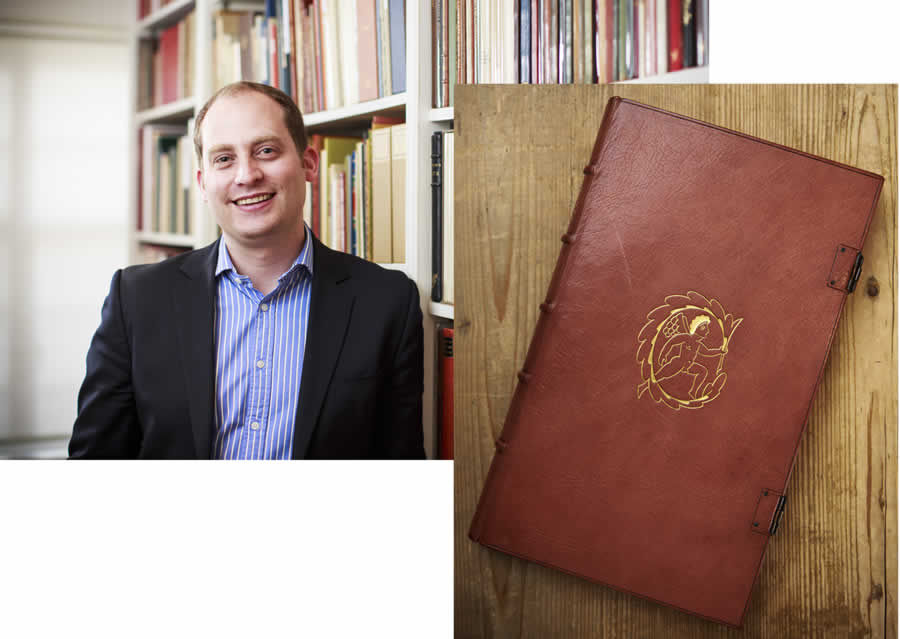
Magical Throwbacks in the Digital Age
JAMES FREEMANTLE FINDS AUCTION HOUSES, BOOK SHOPS, FELLOW COLLECTORS CRUCIAL TO HIS PASSION
As the 1678 edition of Paradise Lost is carefully placed on the law office table, amid a dozen stunning private-press books with vellum proof pages, James Freemantle exults, “These rarities have a terrific sumptuousness.
“The hand-made paper like this one is just gorgeous,” the collector says. “It is an expensive hobby, especially since I have over 1,000 private-press books … usually produced by a single individual using hand-made paper, luxury bindings and offered in very limited editions. So they are very romantic, a magical throwback against the digital age.”
A solicitor-advocate and partner in the London firm Bircham Dyson Bell, Freemantle, 38, says his passion for collecting was stoked by his acquisition of a “glorious” Doves Press edition of Paradise Lost at a Heritage auction 10 years ago. Now owning a few hundred private-press editions of John Milton’s legendary classic (several by the coveted Golden Cockerel Press, with wood engravings), Freemantle explains, “I just love the story, the imagery, and remember, he wrote it despite his being blind.”
Ever the ardent Miltonian, Freemantle was selected to curate an exhibit last summer at Milton’s Cottage in Buckinghamshire to celebrate the 350th anniversary of the book’s first printing.
Studying English literature before attending London’s prestigious College of Law, Freemantle is recommended by City Wealth and the Legal 500, two renowned badges of honor in legal circles. Litigating cases presents keen challenges, yet as this soft-spoken, resourceful collector sits in his St. James’s Park office after a stressful day in court, he eagerly wants to talk about his treasured books.
“Look at this wonderful 1929 Golden Cockerel edition of The Canterbury Tales with wood engraved illustrations,” he says, relishing the binding and vellum pages (“A book,” he says, “is a tactile experience … the oils on human skin are good for the binding.”) His Eric Gill copy is one of only 13 known.
Other unique items are his 1903 Essex House Press songbook specially made for printer Charles Ashbee’s daughter (it features hand-written annotations to her). “He and these other small, non-commercial printers did books solely out of love,” Freemantle says. “That’s why these books are art, why they are a visual delight.”
Emphasizing his passion for hand-bound bindings and various illustrated ephemera, he points to a Kelmscott Press book by designer William Morris, who started the modern private-press movement in the 1890s as a reaction to poorly printed, machine-made Victorian Era books. “To find the books one really wants,” Freemantle says, “it’s imperative to be connected to every potential avenue: private individuals, fellow collectors, book shops and auction houses.”
During numerous “thrilling chases,” Freemantle has suffered setbacks – “The books one doesn’t buy. … Missed opportunities.” Yet the pursuit still fascinates him since there’s the “joy of possession, the creativity of forming a collection.”
Asked about the one book he considers his Holy Grail, Freemantle replies without hesitation, “I would feel a great success in finally owning the Eragny Press [edition of] Whym Chow, 1914. It’s an incredibly rare and desirable book.”
Enlarge
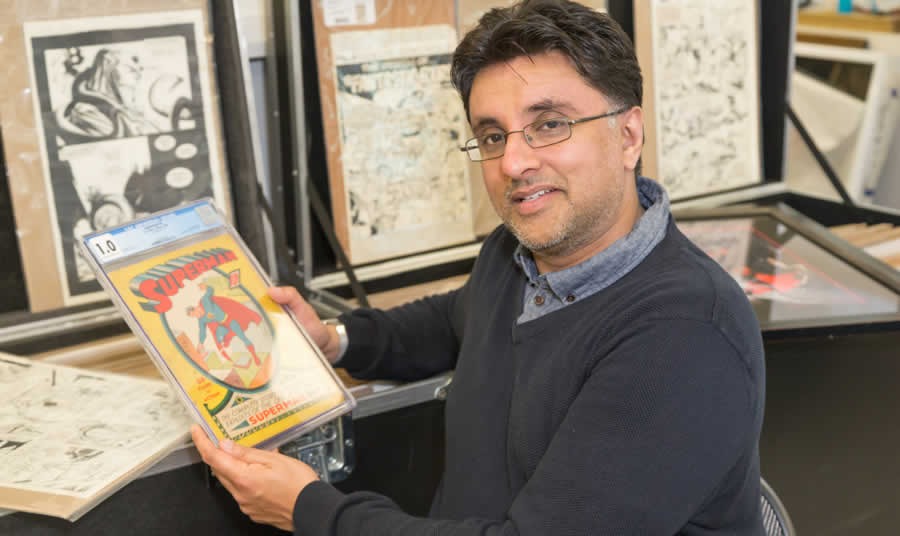
Comic-Book Therapy
CO-FOUNDER OF LONDON SUPER CON IMRAN AHMED SEES COLLECTING AS A WAY TO ESCAPE
In a world darkened by the forces of evil, Dr. Imran Ahmed has found a joyful escape in the law-and-order figures of comic books.
“Superheroes initially appealed to me as perhaps the ultimate good guys,” Ahmed says. “They lived in a simplistic world with good and evil, and they took action to make the world a better place.”
Ahmed, 44, a general practitioner “in the wilds” of Norfolk, England, is a co-founder of the London Super Comic Convention, the UK’s largest comic convention. Joe Mannarino, director of comics and comic art at Heritage Auctions, calls Ahmed one of the most connected and influential collectors in Britain. “Besides having a terrific eye and a great appreciation for aesthetic images, Ahmed knows context, history and the values factor of comic art,” Mannarino says. “With his knowledge, it’s understandable that he produces a great show in London.”
As an official in the National Health Service, responsible for managing the emergency care needs of 160,000 patients – and their continuing welfare – Ahmed, who faces constant pressure, can also be viewed as a superhero of sorts. “I love being a family GP, not just treating sick patients but helping in positive situations as well as pregnancy and helping give preventative advice,” he says. “The daily challenge of never knowing what may walk in through the door is quite intellectually stimulating.”
But Ahmed needs to occasionally “take a break from the rather insular world of medicine.”
Previously focused on Batman and devoting his energies to early pre-Robin Batman comics, Ahmed has been increasingly specializing in original comic art over the past six years. Along with acquiring pieces from the 1960s, he pursues pages by Jack Kirby (Captain America), Don Heck (Iron Man), John Buscema (Fantastic Four), and George Perez (Wonder Woman).
“I’d love to own original art by Steve Ditko, Frank Miller, and always wanted some Watchmen art,” Ahmed says. “I love the artwork. The more sophisticated take on the genre provided by books such as The Dark Knight Returns and Watchmen back in the 1980s opened my eyes to the possibilities of the art form.
“Owning the original pages to some of the stories that I loved as a child, and buying pages from new titles is probably an escape from the pressures of work. But,” Ahmed adds, “the artwork doesn’t just have nostalgic values. Ditko is the master of an art form who helped start the Silver Age of comics. It would be superb to own a piece of history, like an early Ditko Spider-Man or Dr. Strange splash.”
Often relying on experts at Heritage Auctions to secure these “historic” pieces (such as a Thor 154 cover by Kirby and Vince Colletta), Ahmed also reaches out to fellow aficionados at his own convention. Feeling that “the UK had neglected a comic-convention experience,” he and two friends staged the first London Super Comic Con in 2011. The event has attracted legends such as Stan Lee, Perez, John Romita Jr. and Neal Adams.
At comic conventions, Ahmed points out, “Collectors can be in an environment that helps them escape the pressures of the world.”
Enlarge
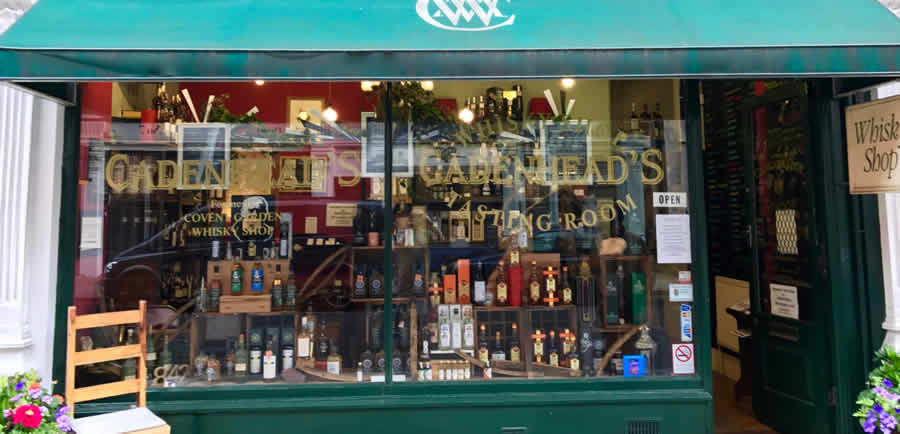
Taking to the Streets
MARYLEBONE, PIMLICO, WHITECHAPEL, PECKHAM DISTRICTS BEST ENJOYED ON FOOT
To fully appreciate London’s bounty of history, amusements and distinctive shopping, the city must be walked. That’s the only way to relish under-the-radar sights and the newly ascendant neighborhoods that merit exploration.
Just off Baker Street, the home of Sherlock Holmes, the well-heeled and suddenly trendy Marylebone is now alive with indie boutiques, organic food shops and restaurants. Wood-paneled Daunt is a classic British bookshop; Chiltern Firehouse is now the ne plus ultra place to be seen sipping cocktails; Ortigia Sicilia carries a remarkable array of soaps, aftershave and scarves; and barrels of whiskeys from Scottish distilleries can be found at Cadenhead’s.
Pimlico is undeniably the street for finding an A-to-Z array of antiques and interior design shops. Near the Victoria and Albert Museum (known as the V&A), Rose Uniacke’s showroom is overflowing with furniture, lighting and textiles; the Ransom Gallery flaunts work from Dali, Francis Bacon, Warhol and an extensive photography collection; and Collier Webb offers handcrafted British lighting and furniture.
Enlarge

To satisfy more macabre urgings, walk around Whitechapel and Aldgate East, particularly Fashion Street and Gunthorpe Street, Jack the Ripper’s old stomping grounds.
A hidden gem, Bruton Street off Berkeley Square Gardens is quintessential luxury, showcasing such shops as Thom Sweeney (men’s clothing); Leica (cameras); Maison Margiela (a Paris fashion house); Rupert Sanderson Shoes; and Ronald Phillips Ltd. (English antiques).
The Burlington Arcade off Bond Street is a similar upscale shopping destination with age-old shops lining its passageway.
The scene of 1981 race riots, Brixton was long off the tourist road map, only to be discovered by graffiti artists. It is rapidly becoming Art Central with pop-up galleries and shops.
On a similar upward spiral, Hackney, which includes Dalston and Haggerston, is the city’s new “fashion capital.” The De Beauvoir Deli Co. is a favorite for many designers. There are numerous shops and stalls on Columbia Road, while Regent’s Canal is flanked by several music venues, cafes and bars.
Experiencing its own makeover, Peckham in southeastern London is turning grim into “garage chic” – a place where parking garages are being converted into funky restaurants and bars. Go there and take in the cutting-edge contemporary art.
Lodging Strategy
SELECTING THE RIGHT HOTEL CRUCIAL TO A SUCCESSFUL VISIT
Location is everything. Especially in London.
Traffic here is exasperating. Taking the Tube offers little relief, since it can mean exhausting up-and-down escalator trips, the studying of countless maps, switching platforms, and long walks to transfer between train lines.
So what do savvy travelers do?
They act strategically when choosing a hotel.
One sublime choice is the Corinthia Hotel. Along with epitomizing luxury with a four-story spa (including a 29-foot pool), three salons for dining, an idyllic cafe/cigar lounge, and sumptuous rooms, this tranquil oasis is only a short walk from many of London’s iconic destinations.
So feast on the 1,001-crystal baccarat chandelier and the scents emanating from the specially appointed “flower room” – and then head off for an adventure, whether that means taking in Big Ben, the National Gallery, St. James’s Park, the Imperial War Rooms, or a lovely walk along the Thames.
A more subdued hotel option is One Aldwych, the perfect choice for avid art- and museum-lovers. Located next door to the often-overlooked Courtauld Gallery, this intimate, luxury boutique hotel sits in the middle of the famed West End Theatre District, and is close to institutions such as the British Museum, British Library, and the numerous sights on the South Bank.
A wide array of top West End restaurants, such as Balthazar, Quo Vadis, and Brasserie Zédel are within walking distance of the hotel. Brilliance is also found in Eneko, the restaurant found in the lower depths of One Aldwych. It offers “simple happy food” like Iberico pork, spider crab, and other innovative Basque delights from three-starred Michelin chef Eneko Atxa.
Enlarge
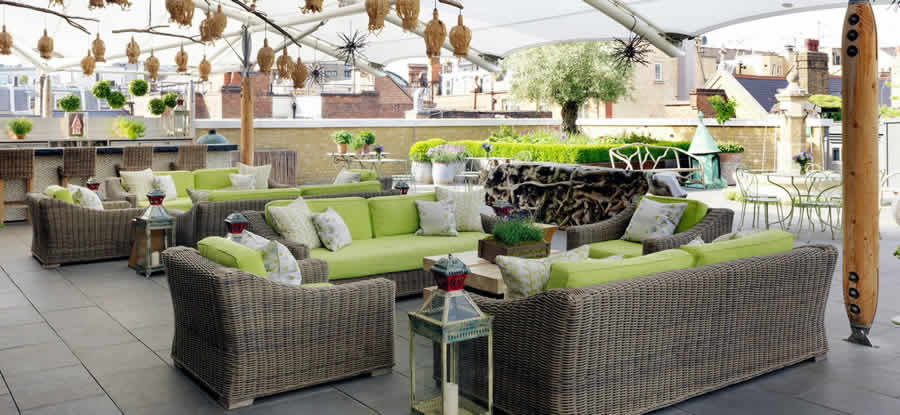
Head-turning treats are even more plentiful at the Ham Yard, a “concept” design hotel off Piccadilly Square in Soho that ambitiously flaunts an “urban village” with 13 individual specialty stores, a 190-seat theatre, outdoor dining and drinking, and a 1950s “Croc” bowling alley imported from Texas.
Owner/designer Kit Kemp has styled a haven that’s all about cool and coziness – from the secluded roof terrace offering skyline views to the drawing rooms with “honesty bars” and surprising artwork.
The Ham Yard is electric, an edgy hotel that reflects the city’s new vibrancy. But when your afternoon jaunts come to an end, guests are rewarded with so many soothing amenities, their next day’s wanderings can be mapped with great hope and promise.
EDWARD KIERSH collects first-edition books and gold coins. He has written for Cigar Aficionado, Vogue and The New York Times.

